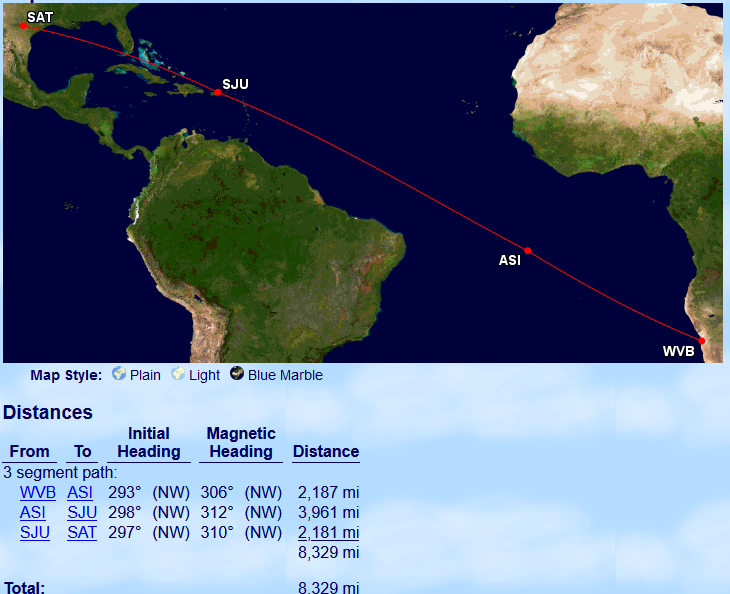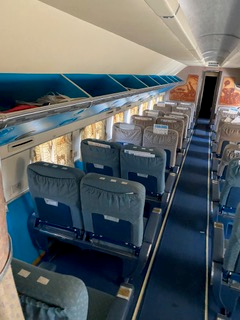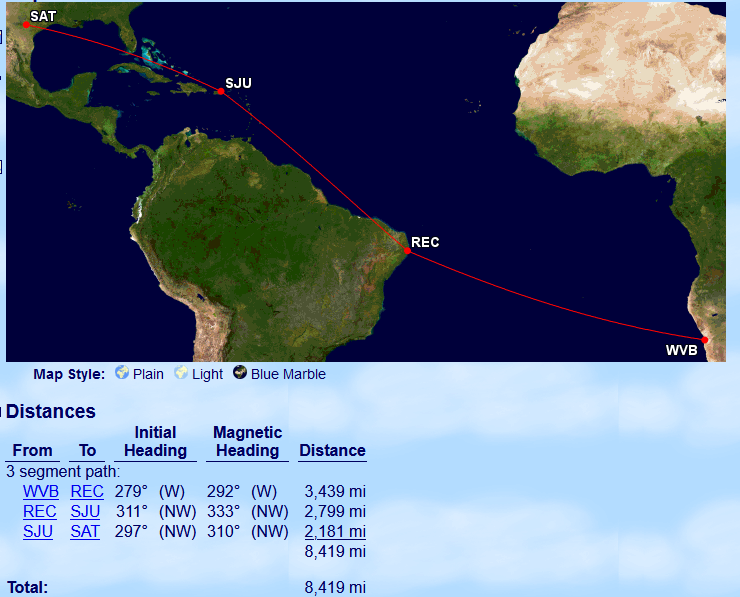Leeham News and Analysis
There's more to real news than a news release.
Pontifications: Last production DC-6 destined to USA
By Scott Hamilton
Sept. 21, 2020, © Leeham News: A Texas man with an affinity for the Douglas DC-6 purchased the last production model, DC-6B that is still in its original passenger configuration.

The last Douglas DC-6 produced has been stored since 2010. It’s now owned by a Texas man. Source: DC-6 Association of Africa.
The DC-6B, delivered in the waning months of 1958, is the sister ship to the famous Red Bull DC-6B that continues to be flown occasionally at air shows.
This DC-6B, registration V5-NCG, has been stored in Namibia since 2010. It once was the presidential airplane for Yugoslav’s leader, Marshal Josip Tito. The plane was then donated to the Zambian government as the presidential aircraft for Kenneth Kuanda. This aircraft and the sister ship were purchased by Namibian Commercial Airlines (NCA). The sister ship, the second-to-the-last built, was sold to Red Bull. The proceeds were used to restore V5-NCG.
More recently, it served in tourist charter work. The aircraft has the original interior. This is a rarity in restored piston airliners.
James Mac Ivor owns Nighthawk Air Systems Inc. near San Antonio. COVID-19 delayed plans to return the airplane to the air. He also still must raise funds.
Getting ready
“I’ve been working on putting together four zero-time engines for the last three years,” Mac Ivor said. “I have four engines ready to go. They’re basically ready. Machine work is complete. I’m just waiting for final assembly getting together the baffles and other small parts to finish them up.”
Mac Ivor is still funding the project by himself. And he’s not even sure what he will do with the airplane once he gets it back to the USA. There hasn’t been interest expressed by other parties yet. However, Mac Ivor hasn’t advertised the aircraft but he’s willing to accept offers, trades or involvement in the project.
The value should be compared with a Boeing B-17 or Consolidated B-24, both four-engined military bombers dating to world War II because of its rarity and original configuration.
Mac Ivor points out that there are two Lockheed Constellations being restored, at a cost of millions of dollars. One is the Bataan, used by Gen. Douglas MacArthur. The other is the Columbine II, used by President Dwight Eisenhower.
Flying on the air circuit is very difficult without a serious financial sponsor. Insurance, for one thing, he said, is a show stopper. Operating costs are also very expensive—upwards of $4,000 to $5,000 per hour.
Mac Ivor said, “I don’t really know what direction I’m going with it yet. There has been some interest but a considerable amount of resources, as mentioned, are required to operate the aircraft. However, it is not impossible.
Engines, propellers and components owned by Nighthawk to be installed on the aircraft are valued at more than $1m. Mac Ivor estimates that he needs an additional $500,000 to get the plane airworthy and ferry it back to Texas.
What’s the future?
The DC-6B, in its tourism operation, was in beautiful shape. The airplane is low time since it was the last DC-6 off the Douglas line in Santa Monica (CA) and only used in presidential service. It accumulated only 10,000 hours total time. Delivered in November 1958, it was already the start of the jet age. The de Havilland Comet and the Boeing 707 entered service that October.
The airplane is a time capsule.
“The aircraft is unique because it’s completely original. It hasn’t been modified. It’s even got the original radio rack and original radios. The radios may or may not work, but they’re not being used. They were left intact to maintain originality,” Mac Ivor says.
Once the DC-6B is here, he hopes interest will be generated and permit operation in the future.
“There’s a small network of people that might be interested in this aircraft,” he said.
“I’ve got a couple more DC-6s in Africa that are never going to fly again,” Mac Ivor said. They may be salvaged for parts and engines. He has engines and spares that could keep the Namibian DC-6 in operation for years.
Return route chosen
Getting the DC-6 to Texas will be a long trip. Namibia borders South Africa, Botswana and Angola. Its West Coast is on the South Atlantic.
“The main route I’m looking at is to avoid coming up the west coast of Africa, because it’s difficult operating through those countries and getting through European air space,” he said. “I ditched that idea a long time ago.
“What I’m looking at is going from Walvis Bay nonstop to Recife (Brazil) or stopping at Ascension Island. Fuel, however, would have to be barged to Ascension. It’s half way between Walvis Bay and Recife. It’s a little island there in the middle of the South Atlantic.
“I was considering stopping there and continuing on from there. If I did that, I might go farther than Recife. I haven’t quite picked it out yet. I can do as few as maybe two stops.”
Mac Ivor said he would clear customs in San Juan then head straight from San Juan to Texas.

A second potential ferry route is via Ascension Island and San Juan. Gasoline would have to be barged to Ascension.
DC-6 affinity
Mac Ivor has an affinity for DC-6s. Nearly 30 years ago, he had ambitions to launch a cargo airline using this aircraft type. But 9/11 intervened and the project never got off the ground.
Still, he acquired several DC-6s, including a military version—the C-118. One partial C-118 has a VIP configuration, which he describes as an Air Force One-type interior. This fuselage section remains intact.
He also has a DC-6B forward fuselage that was delivered to Northeast Airlines and a DC-6A forward fuselage that was the first airliner delivered to Japan Air Lines after World War II.
All these aircraft and spares could be sold as a package with the Namibian DC-6B.





At last one good news. Thanks Scott.
In the downtown area of St. Paul, MN there was a DC-6 parked for many years by the business airport. It was purchased and move out by truck a few years ago. I thought the intent was to get it flying, but maybe it is being used for parts. Fascinating aircraft…
I think that the Airplane you’re thinking of was a DC-7 . There was a DC-7 which sat for many years at St Paul Downtown airport. It was sold and flow out of St Paul to Opa Locka where it was restored with a vintage Eastern Airlines paint job. It was flown to airshows and such for a few years and is currently on static display in Charlotte NC
That was was a DC-7B, after being restored in Florida and out flying, funding stalled after an engine failure in 2009 it has been parked in Charlotte outside the US Airwsys museum ever since. It take a tons of money and support to keep these aircraft flying. Bummer for all involved
Your DC-6 was a DC-7 and previously described in a Leeham article:
https://leehamnews.com/2011/05/26/historical-flight-foundations-dc-7b-trip-report/
Thanks for the postings, and correcting and updating me, on the disposition of the DC-7 (not a DC-6) at the downtown St. Paul, MN airport. Also, the linked story is great history for the old Douglas aircrafts. Great pictures by Scott, too. (After-the-fact: It would be hard for a layman to distinguish the differences in the four engine Douglas prop planes (DC-4 – 7s).)
It is easy to distinguish a DC-4 from a DC-6 or DC-7. The tail is different, and the DC-4 has oval windows, not rounded square ones. The DC-7C has a longer fuselage and a higher more squared off tail. From a distance it is difficult to distinguish a DC-7 or DC-7B from a DC-6B, unless you can see the propellers. The DC-7 and DC-7B have four bladed props while the DC-6B has three bladed. The DC-6 is usually easy to distinguish from a DC-6A or DC-6B as its fuselage is shorter especially in front of the wing. I flew as a passenger in many DC-6, DC-6B, DC-7, and DC-7B aircraft, and I have no trouble at all.
Easy to distinguish:
DC-4 has oval windows.
DC-6: Square windows and three-bladed props.
DC-7: four bladed props, and if it’s the DC-7C, a taller tail.
Please put me on any mailing list regarding the progress of this restoration
We don’t have a mail list for this.
Thanks Scott. Spent more than a few hours in one of those chugging through the clouds (usually in weather it did not fly high enough to be on top)
I believe we still have a number of those flying up here with Everts air on cargo service.
Always a treat to hear the roar of 4 radials sort of workign together.
If the C-118 you speak of is in Zuehl at the Zeuhl Airport I went there last year to verify that it was the aircraft I was told it was. I was told it was BuNo 533279 and in fact it was. I flew that aircraft on active duty and in fact flew it on it’s last flight on active duty to Davis Monthan AFB Feb 1985. I have many flight hours in 279. The aircraft looked good for just sitting. I did call Mac Iver And got vmail but never heard back. I think 279 could be brought back to life but that’s just my opinion but to go along with that I have many years of experience in the C-118/DC-6 and 7’s. In and out of the military. Feel free to contact me.
Jim MacIVOR
Text or call 305 794 2703
hey
give me a call or text me,
trying to get hold of you
305 794 2703
Jim
The VC-118B fuselage at Zeuhl is BuNo 128427. The BuNo referenced above is not a valid number. They are currently in the 170000 series.
USAF serial number. 533279 was used by the USN until Feb of 1985. No Buno issued individually by the USN for it. I flew 279 to the bone yard in 1985 from NAS Willow Grove Pa where it and I were assigned to VR-52.
Ah, the DC-6, B version with higher power IIRC. I only worked o them a bit, was around them often.
Always bemused that the Canadian military scabbed the Douglas DC-4/DC6 cockpit onto a Brittannia fuselage.
Airbus’ attempted Frankenplane smear on Boeing was nothing compared to what the Argus was. Brittannia fuselage but not pressurized (to facilitate observation blisters I think), wings, landing gear, and tailfeathers with Douglas nose and Wright Turbo-Compound engines as on DC-7C.
Engine change was to get more fuel mileage for endurance. Turboprops are good but apparently the old roundy was better.
I presume Douglas nose was used to re-use stuff from earlier Canadian military aircraft. It had been produced in Canada on the DC-4M, but the Brittannia was also produced in Canada as the CL-44 which Canada operated as executive transport, and cargo operators used. Nicer nose but perhaps DC-4 nose had better vision over it.
Almost pitiful was one of its last operations, patrolling the Beaufort Sea – a 23-hour round-trip mission out of Comox CFB, high rate of mission scrub due engines.
No one else says that Canadair put a DC6 cockpit section on the Bristol Britannia they licensed for their CL44 versions ( Argus , Yukons etc)
Yes the Argus had a DC6 like cockpit but the Yukon and Cl 44 versions looked exactly like the Britannia. Did just have a flatter glazing for the cockpit windows and of course a observer position in the nose section.
The Douglas DC-4 had been licensed by Canadair as the Northstar but had a DC-6 nose, but that cockpit glazing was more v shaped not flat like the Argus.
An interesting claim
The CL-44 used cockpit windows from the Convair 880, IIRC, due US certification issues with the number of frames and curved glass in the Britannia’s windscreen. I
The Argus was a capable airplane; the reason for the piston engines (R-3350 as used on DC-7, Super Constellation) was for lower fuel consumption at sea level patrol altitudes. Apparently it was quite well regarded as an antisubmarine platform. Canadair built the fuselage; I’m not aware of any Douglas parts being used- perhaps you are thinking of the earlier Northstar, which was a Merlin-engined, pressurized development- by Canadair -of the DC-4.
Correct, the commercial version of the CL-44 used a cockpit section adapted from the Convair 880/990, although the CL-44 fuselage was wider than the 880/990 which could only accommodate 5-abreast in economy vs. 6-abreast on the CL-44/Britannia. Both Canadair and Convair were then owned by General Dynamics.
However, the RCAF’s “Yukon” version of the CL-44 had the original Britannia cockpit section with the multiple smaller windshield panels.
No one else says ot because the Argus does not have C-54/DC-6/DC-7 nose. The two main winshield panels may be identical, but the Argus Cockpit is wider. The Britannia fuselage was quite a bit wider than the Douglas. Both the Britannia and CL-44J sat six across in coach.
Ah, the DC-6, B version with higher power IIRC. Only worked o them a bit.
Always bemused that the Canadian military scabbed the Douglas DC-4/DC6 cockpit onto a Brittannia fuselage.
Airbus’ attempted smear on Boeing was nothing compared to what the Argus was. Brittannia fuselage, wings, landing gear, and tailfeathers with Douglas nose and Wright Turbo-Compound engines as on DC-7C.
Engine change was to get more fuel mileage for endurance. Turboprops are good but apparently the old roundy was better.
I presume Douglas nose was used to re-use stuff from earlier Canadian military aircraft. It had been produced in Canada on the DC-4M, but the Brittannia was also produced in Canada as the CL-44 which Canada operated as executive transport, and cargo operators used. Nicer nose but perhaps DC-4 nose had better vision over it.
Almost pitiful was one of its last operations, patrolling the Beaufort Sea – a 23-hour round-trip mission out of Comox CFB, high rate of mission scrub due engines.
(In the 70s the Canadian government sought bids for a replacement ice patrol aircraft, to replace their old DC-4s.
We studied that at PW, thought a 707 would be needed to carry all they wanted (comfort space and features plus all the electronics and radar needed then – a typical overdone want list).
Boeing confirmed that using only two engines at low altitude would safe fuel, but I don’t know how deeply we thought about reliability.
Preventative maintenance is key, PW’s 707 pax charters were reliable for that reason. Old-time mechanics marvelled at a 707 returning from one very long itinerary, it could have been turned in two hours whereas a DC-7C would have needed at least two jug changes.
We instead chose the Electra but decided not to have a remote operation even though we operated Electras in pax service, Nordair of Quebec picked up the work Lockheed did for us and put it into operation.
Today a biz jet zips over the ice and datalink maps to boats ad shore.)
Decades after the ice patrol exercise I worked on a proposal to upgrade old C-130H type airplanes for an Allied military – same overdone wish list.
I muttered that they really wanted C-17s, not even new Hercs.
Folks, there is a way to provide a wish list sensibly.
PS: Icebergs are a major threat to shipping near Newfoundland at certain times of year, they calve off of Greenland and perhaps adjacent Canadian islands and float south.
I suppose satellites help today, but relatively low flying sensors should give better imagery.
Trivia: When Dan McIvor set up a forest fire fighting operation for landowners on Vancouver Island he had the TC engines replaced by non-TC versions originally used on the Martin Mars, to ensure reliability.
(He bought four Mars and large quantities of spare parts for a song.
USN had stopped using the long-range transport because it was slow and increased availability of land airports in the western Pacific reduced need.
I have been near the beast, seen it in operation, knew the designer of the structural conversion to dump liquid, and met McIvor a few times.
Today two still exist in close to flyable condition, but the BC government is biased against using their big dump and operations in the US are awkward due to environmental concerns of spreading organisms between lakes, plus remote operations are costly. (When fighting in BC they took the beast home every night to do mx and refuel with super high octane fuel, for AB they have a tank truck and big maintenance truck.) Current owner Wayne Coulson tried to trade one to a museum in FL for parts for his C-130 water bombers, but armament bureaucracies of Canada and the US stalled him endlessly – no common sense, it is old stuff widely used around the world. (His C-130s operate in the US not Canada, though seasonally they help Australia fight fires.)
Coulson flew the better of the two Mars to OSH one year and demonstrated it, unfortunately tore a hole in the belly taxing with a full load of water after aborting pickup run due apparent engine anomaly. It was ferried back to its base near Port Alberni BC.
Coulson had been offering type qualification visits to pilots with a few thousand dollars to spend on adding it to their license. IIRC two days beginning with lessons on piloting flying boats. With Coulson flight engineers and safety pilot of course.
Do-gooders in Port Alberni BC, near which the Mars are based, try to coerce Coulson into donating one to keep locally. Sadly it might happen, the base would add to parks in the area.
In its heyday as fire fighter the Mars had dedicated maintenance crews as even its lesser roundies need TLC.
If interested, an episode of Might Planes TV show was made during an operation fighting fires in northern Mexico out of a reservoir in TX.
There are enough enthusiest around that would contribute to a go fund me page. Look at the southern WWII ferry route for your flight, and look for sponsors for fuel and oil.
Contact me; I have some ideas for once you get it home….
My text is 305 784 2703
Sorry
I typed the incorrect contact info
305 794 2703
Or email
Nighthawkair@gmail.com
I have flown several times on that machine in Namibia. For a while, it was in regular scheduled service for Air Namibia to/from Harare. Beautiful inside the cabin.